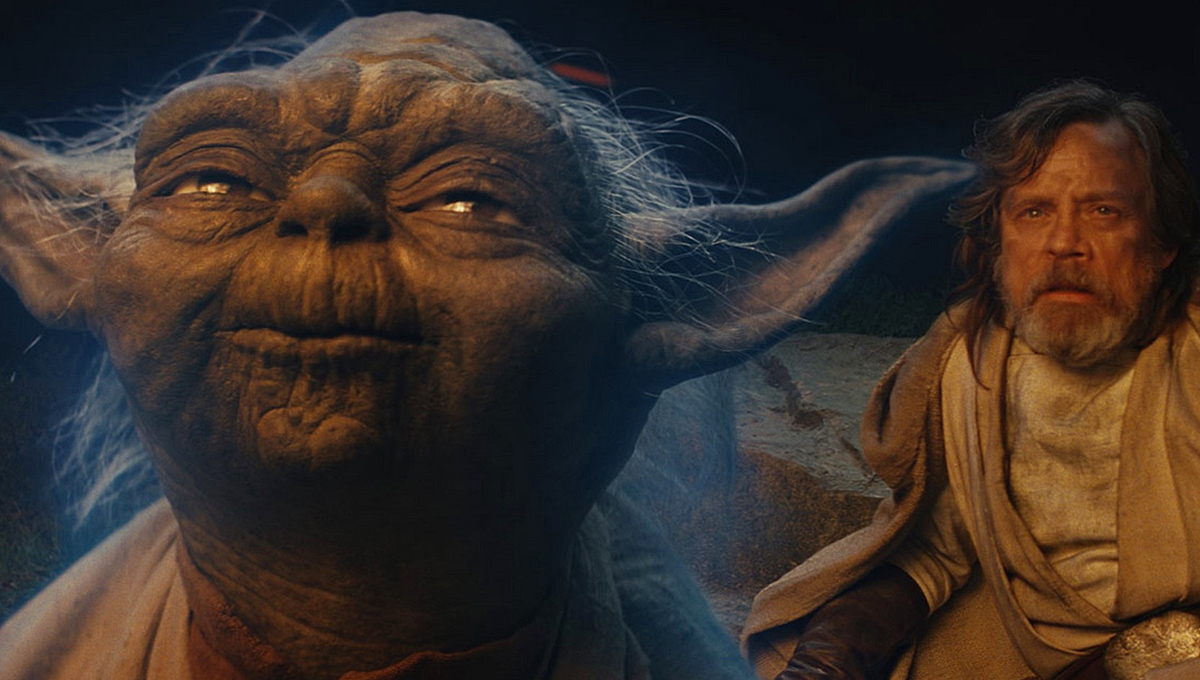Star Wars Sequel Trilogy 2017 middle act The Last Jedi may have a share of detractors for numerous reasons, but the 2019 release of J.J. Abrams’s closing follow-up, The Rise of Skywalker, and three whole years of hindsight have put it into perspective, generating a unique appreciation for director Rian Johnson’s renegade franchise offering. However, Johnson has revealed that a key scene almost revisited one of the most maligned retroactive alterations to the sacred Original Trilogy: Hayden Christensen’s Force Ghost Anakin Skywalker.
Johnson recently provided a potent answer to a fan’s question on Twitter about an unrealized concept for The Last Jedi that would have seen Luke Skywalker (Mark Hamill) reunite with a spectral version his formerly wayward father, Anakin Skywalker, played by Christensen. As it turns out, the idea was ultimately nixed in favor of a key scene in which Luke instead has a more familiar reunion with Ghost Yoda.
When asked if he ever considered including Force Ghost Anakin, Johnson explains, “Briefly for the tree burning scene, but Luke’s relationship was with Vader not really Anakin, which seemed like it would complicate things more than that moment allowed. Yoda felt like the more impactful teacher for that moment.”
The scene in question reflects the lowest point of disillusionment and despair in Luke Skywalker’s arc; an idea that is the center of much of the film’s controversy. With the film still focusing on Rey (Daisy Ridley) and Luke’s island meeting on the planet Ahch-To, the scene shows Luke arriving at the ancient tree that houses the sacred Jedi texts, brandishing a torch with the intent of burning the tree, and the library he now eschews, within its hollow shell. However, Luke hesitates, and Force Ghost Yoda materializes and relieves him of his ambivalence by summoning a bolt of lightning from the sky (not his hands like the Sith,) to cathartically burn it all down before characteristically dispensing wisdom. Yet, as Johnson points out, the idea of having Anakin serve this sagely purpose instead of Yoda would have unnecessarily complicated the story. Moreover, it would have felt unearned from a narrative perspective, since it doesn’t accurately reflect the bond we saw.
Read more
Pertinently (and at the risk of kicking a long-dead horse), this logic arguably applies to the widely-held opinion that Hayden Christensen playing Force Ghost Anakin—as we first saw notoriously retconned into 1983’s Return of the Jedi—was a mistake overall. Notwithstanding the mixed (but slowly-warming) feelings among the fandom regarding Christensen’s performances as the teenage version of the character in 2002’s Attack of the Clones and 2005’s Revenge of the Sith, the concept remains anachronistic from a story standpoint and disrespectful in its erasure of Sebastian Shaw (who passed away back in 1994 at the age of 89,) as the spectral, smiling and redeemed version of the former Vader—the one we actually saw under the mask earlier in the film!
George Lucas’s now-famous explanation for the Anakin swap was that Christensen’s young Anakin reflected the idea that, in returning to the Force, the “inner person would go back to where we left it off,” which, indeed, was that version. While the move was (and still is) rather puzzling, it was contemporaneously intriguing, since it was 2004 and prequel closer Revenge of the Sith was still a year away from release. Thus, the scene provided a first official glimpse of Christensen’s Anakin with the long hair that he would sport in that film. Plus, it complements the DVD’s other major alteration to the character in Return of the Jedi, the digital deletion of the eyebrows once seen on Shaw’s unmasked Vader; a move that provided a crucial clue about Anakin’s fiery fate (remember, we still didn’t know for sure how his Vader-transforming injuries occurred).

Yet, the “inner person” argument could be retorted with the idea that Force Ghosts—visible manifestations of the ascended Jedi’s incorporeal essence as part of the living Force—would more likely take a form familiar to the person to whom they deign to appear, in this case, Luke. As Johnson accurately points out, Luke only knew Anakin as Darth Vader and the chalky, scarred visage underneath the mask, as played by Shaw (now with some digital depilation).
Consequently, when Return of the Jedi had a victorious Luke see the just-perished Anakin join Obi-Wan and Yoda to comprise a spectral trio of his own mentor figures (and not, say, Qui-Gon Jinn or Mace Windu), it supports the idea that the appearance of their ghostly manifestations are reflective of his own experiences. This is especially true, since Leia—established to be Force-sensitive at this point—did not even see them, despite looking in the same direction. While one might point out that the voice of Christensen’s Anakin is briefly heard amongst other long-gone Jedi by Rey in The Rise of Skywalker, the concept doesn’t exactly match the more personal, acquaintance-requisite experience of a visit by a Force Ghost, which she did get when Luke’s Force Ghost appeared to her.
Regardless, despite the various maligned aspects of The Last Jedi, there is a high probability that most fans will, in the very least, agree that Rian Johnson made the right call in his choice of Force Ghosts. It might end up being the first step into a larger world… of acceptance for the 2017 movie.


